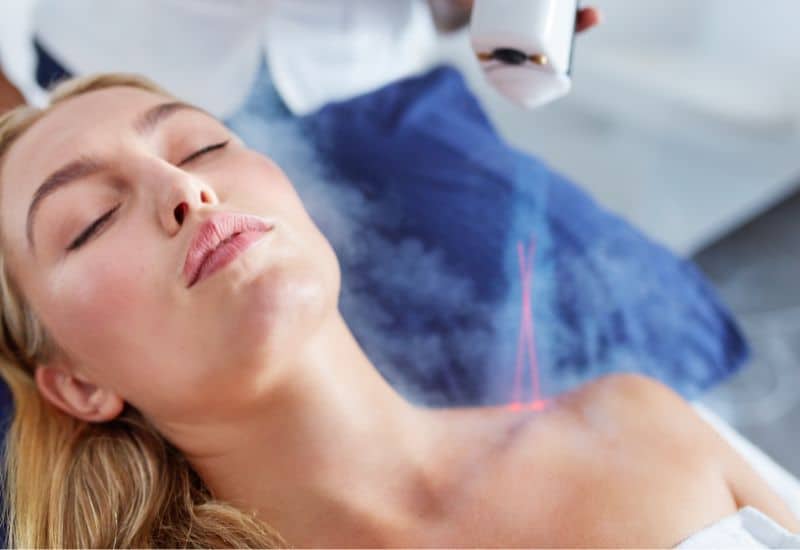Procedures
Skin Graft Surgery

Surgery can sometimes feel daunting, but when you understand the process, it helps to alleviate some of your worries. Among many surgical procedures, skin grafting is one that is highly beneficial for various conditions. It’s a procedure that has transformed the lives of many and continues to be a staple in reconstructive surgery.
Skin graft surgery is an operative procedure where a piece of skin is removed from one area of the body (the donor site) and transplanted or attached to another (the recipient site). It’s a common procedure, often performed to treat extensive wounds, burns, or areas of skin lost to infection or disease. The primary aim is to speed up healing, reduce the impact of long-term scarring, and, in many cases, save lives.
Anca Breahna is an experienced and talented consultant plastic surgeon regularly performing different types of non-surgical and surgical procedures, including skin graft surgery.
At a glance
Depends on the type of procedure performed
General Anaesthesia
Several weeks
Table of Contents
What is Skin Graft Surgery?
Skin graft surgery involves moving skin from one area of your body to another. It’s a procedure commonly used to cover areas where skin has been damaged or lost. This could be due to various reasons such as burns, injuries, or surgical removal of diseased skin. The operation works by taking skin from a healthy part of your body (the ‘donor site’) and transplanting it to the area that needs help (the ‘recipient site’).
Who Needs Skin Graft Surgery?
Skin graft surgery is usually performed on individuals who have lost a significant portion of their skin due to various reasons. Here are some instances when one might require a skin graft:
- Severe burns: Extensive burns can cause considerable skin damage, making skin grafts necessary for healing
- Large, open wounds: If a wound is too large to be closed with stitches, a skin graft might be needed
- Skin infection or disease: Conditions like necrotising fasciitis (flesh-eating disease) or skin cancer might necessitate the removal of a large area of skin, requiring a graft
- Bedsores or ulcers: Chronic skin conditions like these, particularly when they aren’t responding to other treatments, may be treated with skin grafting
- Surgeries that require tissue removal: Some surgeries, such as mastectomies, may require skin grafting afterwards for optimal healing and aesthetic results
Not everyone is a suitable candidate for skin graft surgery. The procedure might not be recommended for individuals with a compromised immune system, poor blood flow, or those who aren’t in a generally good state of health. It’s also worth noting that the procedure can’t be performed if there isn’t an appropriate donor site available on the patient’s body. Anca will discuss these considerations with you before determining if skin graft surgery is the best option for your situation.

Benefits of the Skin Graft Surgery Procedure
Skin graft surgery carries several benefits, depending on the specific circumstances and requirements of the patient:
- Promotes healing: Skin grafting can significantly speed up the healing process, particularly for large wounds or burns. It provides a protective layer that aids in the overall healing and regeneration process
- Prevents infection: By covering exposed areas, skin grafting can effectively reduce the risk of infection, a significant concern with large open wounds or burns
- Improves function and appearance: Skin graft surgery can be instrumental in restoring both function and appearance, particularly in cases where significant skin loss has occurred. Although it might not perfectly match the surrounding skin, it can still offer significant aesthetic improvement
- Life-saving in severe burns or wounds: In extensive burns or injuries, skin grafting isn’t just beneficial; it’s potentially life-saving. By quickly covering a large, exposed area, it significantly reduces the risk of fatal complications like sepsis
Types of Procedures
Split-thickness Skin Graft (STSG)
In an STSG, Anca removes the epidermis (outer layer) and a portion of the dermis (inner layer) from the donor site, typically the thigh, buttocks, or upper arm
The harvested skin graft is then carefully placed over the recipient site and secured with sutures or staples
STSGs are suitable for large wounds and areas with minimal blood supply, such as burn injuries, as they require less blood vessel support for survival
The donor site regenerates on its own, usually within two to three weeks
Full-thickness Skin Graft (FTSG)
FTSG involves the removal of the entire thickness of the skin, including both the epidermis and the dermis, from the donor site. Common donor sites include the abdomen, chest, or back
Unlike STSG, FTSG provides a thicker and more durable graft, making it suitable for areas that require additional strength and resistance, like the hands or joints
The graft is sutured or stapled to the recipient site, and sutures are also used to close the donor site
FTSGs tend to have a better cosmetic outcome as they retain more of the natural skin characteristics of the donor site
Composite Skin Graft
Composite grafts include both skin and underlying tissue, such as fat or cartilage, which are taken from the donor site
These grafts are utilised in complex reconstructive surgeries where additional structures are required, such as in the repair of deep facial defects
How is the Skin Graft Surgery Procedure Performed?
Skin graft surgery often requires a hospital stay and is performed under general anaesthesia. Here’s a general step-by-step overview of the process:
- Preparation: The first step is preparing both the donor and recipient sites. Anca cleans and sterilises both areas to minimise the risk of infection
- Harvesting the graft: Your plastic surgeon uses a special tool, often a dermatome, to remove the skin from the donor site. This could be the thigh, buttock, or upper arm. The type of graft (full-thickness or split-thickness) dictates how much skin is removed
- Preparing the recipient site: The wound is then cleaned, and any dead tissue is removed, a process known as debridement
- Transferring the graft: The harvested skin is carefully spread over the wound and held in place using stitches, staples, or special glue. A dressing is then applied over the graft to protect it and help it adhere to the surrounding skin
- Closing the donor site: If a full-thickness graft has been taken, Anca will close the donor site using stitches
- Aftercare: You are then taken to recovery. The graft will be regularly monitored to ensure it’s ‘taking’, i.e., establishing a blood supply and healing well
There are several types of skin graft procedures, each tailored to address specific conditions and patient needs. The choice of procedure depends on the size of the wound, the location of the injury, and the availability of healthy donor skin. The two main types of skin graft procedures are: Split-thickness Skin Graft (STSG), and Full-thickness Skin Graft (FTSG).

Recovery after Skin Graft Surgery Procedure
The recovery process after skin graft surgery can vary greatly from patient to patient, influenced by factors such as the size and location of the graft, overall health, and age.
- Pain management: Pain at both the donor and recipient sites is common. You will be prescribed pain relief medication, which should be taken as instructed
- Hospital stay: A hospital stay of a few days to a week is common, particularly for larger grafts. This allows the medical team to monitor your recovery closely
- Graft checks: The medical team will regularly check the graft to ensure it is taking well. This is vital in the early stages of recovery
- Home care: Once discharged, it is essential to keep both the graft and donor site clean and dry. You will be given specific instructions on how to care for your wounds at home
- Activity level: Light activities can usually be resumed after a few weeks, but strenuous activity should be avoided until your doctor gives you the all-clear
- Follow-up appointments: You will have several follow-up appointments to monitor your healing progress and manage any potential complications
Further Reading
- Read Anca’s Blog on Looking for Skin Cancer Treatment near Chester?
- Read Anca’s Blog on Treatments for Nerve Lacerations and Trauma Damage

Procedure
Frequently asked questions
Is skin graft surgery painful?
While skin graft surgery itself is performed under anaesthesia, you may experience some discomfort and pain during the recovery period. Your plastic surgeon will prescribe pain medications to manage any post-operative pain. It’s essential to follow Anca’s instructions and take the prescribed medications as directed to ensure a more comfortable recovery.
How long does it take to recover from skin graft surgery?
The recovery time for skin graft surgery can vary depending on the size and location of the graft, as well as your overall health. In general, it may take several weeks for the graft to fully heal. During the initial days after surgery, you may need to rest and limit movement to allow the graft to establish a blood supply. Your plastic surgeon will provide specific post-operative care instructions to facilitate a smooth and successful recovery.
Will there be scars after skin graft surgery?
Yes, there will be scars both at the donor site and the recipient site after skin graft surgery. The appearance of the scars may fade over time and can be influenced by various factors, including the type of graft used and your body’s natural healing process. Your plastic surgeon will take care to minimise scarring and may recommend scar management techniques, such as silicone sheets or creams, to improve the final appearance.
Can I resume regular activities after skin graft surgery?
Your ability to resume regular activities will depend on the extent and location of the graft, as well as your healing progress. In the initial stages of recovery, you may need to avoid strenuous activities and protect the graft from excessive strain. Anca will provide specific guidelines on when you can gradually resume normal activities, including work and exercise, to avoid complications and ensure proper healing.
Are there any potential complications associated with skin graft surgery?
Like any surgical procedure, skin graft surgery carries some risks. Potential complications may include infection, graft failure, bleeding, and scarring. It’s important to follow your plastic surgeon’s pre and post-operative instructions carefully to reduce the risk of complications. If you experience any unusual symptoms, such as increased pain, redness, or drainage from the graft site, it’s essential to contact your medical team promptly.
What are the risks of skin graft surgery procedure?
Like all surgical procedures, skin graft surgery does carry some risks and potential complications. While the surgical team takes every precaution to mitigate these risks, it is important to be aware of them before the surgery. Here are some potential risks associated with skin graft surgery:
- Graft failure: This is when the skin graft does not ‘take’ to the recipient site, often due to poor blood flow or infection. In some cases, a second graft may be necessary
- Infection: As with any surgical procedure, there is a risk of infection at both the donor and recipient sites. The surgical team will take steps to minimise this risk, and you’ll be given instructions on how to care for your wounds at home
- Scarring: Both the donor and recipient sites will likely have some degree of scarring. The severity can depend on a variety of factors including the individual’s healing response, the site of the graft, and the type of graft used
- Pain: Pain at both the donor and recipient sites is common after surgery. While this can generally be well-managed with pain relief medication, in some cases, the pain may persist
- Changes in skin sensation: You may experience changes in sensation at both the graft site and the donor site. This can include areas of numbness or increased sensitivity
- Bleeding: There’s a risk of bleeding from the donor or recipient site, which can occasionally require further surgical intervention
- Cosmetic outcome: Although skin grafting can significantly improve the appearance of a large wound or burn, the grafted skin may not match the surrounding skin perfectly. This can result in a noticeable difference in skin texture and colour.
Medical References about Skin Graft Surgery
- Skin Graft – Cleveland Clinic
- Skin Graft Skin Graft How It’s Performed – NHS
- Skin Grafting – NCBI
- What To Know About a Skin Graft – Medical News Today
- Plastic Surgery for Burns and Other Wounds – WebMD






